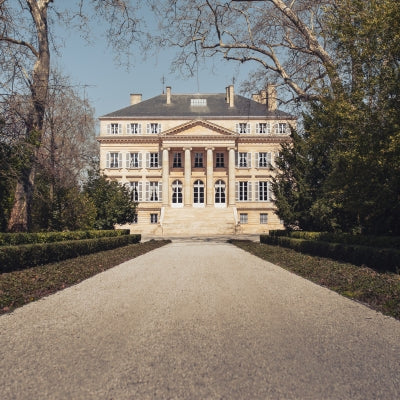
Exploring the Neoclassical châteaux of Bordeaux
Adding to the incredible provenance and heritage of its fine wines, the architecture of Bordeaux is often equally as dramatic as the wines are iconic. Among the wide array of architectural styles represented in the region, Neoclassicism holds a special place, particularly among the famous 1855 classified growths.
These estates, built or renovated in the 18th and 19th centuries, reflect the elegance and grandeur associated with Neoclassical design.
What is Neoclassical architecture?
Neoclassical architecture emerged in the mid-18th century as a response to the elaborate and exuberant styles of Baroque and Rococo. It is a reinterpretation of more classic antiquity, drawing inspiration from ancient Greece and Rome, emphasizing symmetry, proportion, and the use of classical elements such as columns, pediments, and domes.
There are three subcategories of the movement: Temple, Palladian, and classic block. The style became particularly popular in Europe and the United States, where it was often used for public buildings, mansions, and, in Bordeaux's case, châteaux.
Neoclassical châteaux in Bordeaux
Château Margaux: the Versailles of the Médoc
Château Margaux is perhaps the most iconic example of Neoclassical architecture in Bordeaux. Upon its acquisition in 1801, the Marquis de la Colonilla, Bertrand Douat, found the original manor house to be unworthy of the estate and its vineyards and commissioned popular French architect Louis Combes to realize his vision of a more befitting château.
Dubbed the "Versailles of the Médoc," the château's façade features a portico supported by Ionic columns, a hallmark of Neoclassical style. It is also a rare example of neo-palladian architecture in France.
Today, the house stands harmoniously with the "Nouveau Chai" designed by Lord Norman Foster in 2015, the only development the estate has undergone in 200 years.
Château Mouton Rothschild: blending Neoclassicism with modernity
While Château Mouton Rothschild is famous for its exceptional Pauillac, its architecture also deserves attention. The château underwent significant modifications in the 19th century, introducing Neoclassical elements into its design.
These updates focused on creating a more symmetrical layout and the addition of classical columns at the entrance, enhancing the estate's grandeur reminiscent of the Temple style of Neoclassical architecture. Dotted around the estate are numerous statues and references to ancient Greek and Roman iconography, as well as a greater collection of artworks that lend a sense of timelessness to the estate.
The combination of these elements with modern winemaking facilities makes Mouton Rothschild a fascinating blend of old and new.
Château Lafite Rothschild: subtle elegance in design
Château Lafite Rothschild strikes a more subtle tone. While the château may not be as ostentatious as many of its peers, it embodies the principles of Neoclassicism through its generous proportions and emphasis on symmetry.
The understated elegance of the main building, with its balanced design and classical motifs including columns and pilasters, reflects the influence of Neoclassical architecture on French wine estates of the 19th century and leaves its true voice to be heard through its wines.
Château Cos d’Estournel: a fusion of Neoclassical and Oriental
Château Cos d’Estournel is a rather striking example of architectural fusion, combining Neoclassical design with exotic Oriental influences. This Second Growth estate features a layout rooted in Neoclassical principles, such as symmetry and grandeur, but with a twist.
Louis-Gaspard d'Estournel would sell a significant portion of his wines directly to India. It was this connection that ultimately inspired the design of the château itself; featuring pagodas, an intricately carved wooden door imported from the Sultan of Zanzibar’s palace, and many other design elements that reflect the owner's fascination with the East.
This architectural curiosity stands out in the Médoc region, adding an intriguing layer to the estate's history and its beautifully structured wines.
Château Pontet-Canet: a Fifth Growth with grand aspirations
Château Pontet-Canet, though classified as a Fifth Growth, produces wines that place among the Super Second in terms of quality, and this performance is fittingly reflected through its grand château.
Redesigned in the 19th century, it features a symmetrical façade with classical details, including columns and a pediment. These elements give the estate a stately and harmonious appearance, showcasing the widespread influence of Neoclassical design in the region, even among the lower-ranked growths.
Château Pichon Baron: Gothic meets Neoclassicism
Pauillac Super-Second Château Pichon-Longueville Baron is a fascinating blend of architectural styles and one of the most visually striking estates in Bordeaux. While the château's dramatic twin conical towers reflect a Gothic influence inspired by the fantastical castles of the Loire Valley, the overall design is rooted in Neoclassical principles.
The building's symmetry and the grand entrance, flanked by classical columns, illustrate how Neoclassical architecture adapted to fit the preferences of the 19th century with bold, complex, and captivating aesthetics akin to the wines themselves.
Château Latour: a restrained Neoclassical monolith
First Growth Pauillac house Château Latour takes its name from the 14th-century fortress tower pictured on the label. This tower no longer exists. However, the main buildings of the château incorporate many Neoclassical elements that often go unnoticed, reserving its true grandeur for those who would only look closer.
Its bold yet restrained design emphasizes balance and elegance, key features of the Neoclassical style, but also highlights the immutable statement between both the architecture of the estate, and the structure of the magnificent Pauillac it is so known for. Its façade is seemingly uncomplicated, giving it a sense of almost monolithic scale akin to a Roman fortress, but up close, the intricacies are revealed by its ornate door, and beyond.
Conclusion
From the grandeur of Château Margaux to the uniqueness of Château Cos d’Estournel, Neoclassical architecture left an indelible mark on this world-famous wine region. By appreciating their design, we gain a deeper understanding of the cultural influences that shaped Bordeaux.
Want to read more? Take a look at some of our other blogs here:
Also in News



